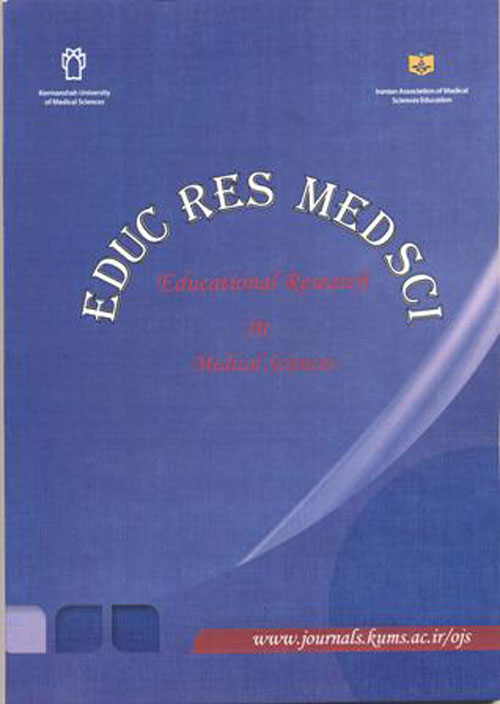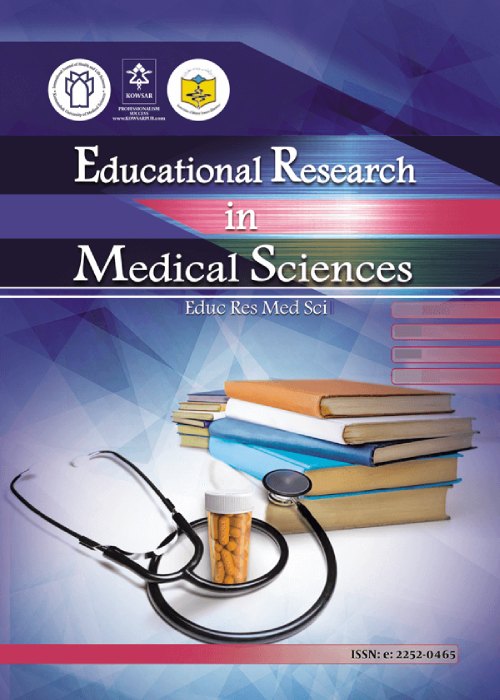فهرست مطالب

Educational Research in Medical Sciences
Volume:5 Issue: 1, Jun 2016
- تاریخ انتشار: 1395/01/23
- تعداد عناوین: 8
-
-
Pages 1-8IntroductionApart from being one of the main objectives in the educational program, acquiring clinical skills is considered as a principle element of competency in a dentist. The aim of this study was to assess students viewpoints regarding the educational quality of clinical skills in different departments of their educational environment.MethodsThis descriptive cross-sectional study was conducted using a self-made questionnaire, comprising of 140 questions designed for four dental departments of pediatrics, oral medicine, radiology and orthodontics. Validity of the questionnaire was confirmed by the tutors and the reliability was more than 90%. Statistical analysis was done using one-way ANOVA, Pearson correlation coefficient, Tukey test, repeated measures MANOVA and LSD paired comparison test.ResultsThe highest scores belonged to activities such as class I & II cavity preparation, and the lowest scores were given to tasks such as pulpotomy and pulpectomy. In the departments of pediatrics, oral medicine and radiology, tutors supervision over students work and in the orthodontics department, students self confidence while performing tasks had the lowest scores. However, level of students theoretical knowledge, regarding the practical skills, obtained the highest score in all departments.ConclusionOur findings confirmed that students have properly acquired essential clinical skills. However, they havent reached the desired level of competency in none-core skills, so they need to receive more effective education in certain areas.Keywords: Clinical skills, Dental education, Students, Assessment
-
Pages 9-15IntroductionLanguage teachers can help students improve their learning of English by employing different approaches and taking into consideration various learning styles of their students. This study is an attempt to reveal the effect of cooperative learning (CL) on enhancing nursing students English pronunciation.MethodsTwenty five nursing students and thirty midwifery students in Yasuj University of Medical Sciences took part in this quasi experimental study as the intervention and the comparison groups, respectively. CL was implemented with the intervention group, dividing them into groups of five while the comparison group was taught through the traditional method. Phonetic transcriptions were used along passages taken from the ESM I book with both groups. The data, collected from three oral tasks, scores of pretest, midterm and final written examinations, were analyzed using the SPSS software, version 19, through independent sample t-test.ResultsThe results of the study showed that the intervention group outperformed the comparison group significantly (PConclusionThis study suggests that CL helped significantly to enhance the nursing student's pronunciation. Teaching pronunciation, done in a cooperative context, yields better learning in students.Keywords: Cooperative learning, Nursing, Pronunciation
-
Pages 16-23IntroductionLearning and study strategies are considered to be among the factors affecting students performance and also are essential for appropriate educational interventions. This study was conducted to determine the relationship between learning and study strategies and academic performance of students in Alborz University of Medical Sciences.MethodsIn this descriptive, analytical, cross-sectional study, 215 students at Alborz University of Medical Sciences studying in various majors in 2012-2013 were enrolled through stratified random sampling. The 10-scale, Learning and Study Strategies Inventory (LASSI) assessment device of Weinstein was used to collect the data. The obtained data were analyzed by SPSS-19 software using descriptive statistics and inferential statistics.ResultsThe median scores of sub scales of LASSI inventory were 28 (attitude), 25 (motivation), 25 (time management), 29 (anxiety), 26 (concentration), 26 (information processing), 29 (selecting main idea), 24 (study aids) and 23 (self-testing). The performance of the students was very unfavorable in terms of using learning and studying strategies in attitude and motivation areas. The results showed that among learning and studying strategies sub-scales, the effects of motivation (F=3.95, PConclusionThe results showed that the use of learning strategies in Alborz University of Medical Sciences was low. Since the use of learning and study strategies to increase the learning capacity and improve the educational quality of students is effective, education officials can use these results to improve students academic performance.Keywords: Student, Learning, study strategies, Academic performance
-
Pages 24-28IntroductionStudents learn similarly in terms of ability and talent, but they have many differences in academic achievement. These differences can be shown not only in school lessons but also in other extra-curricular activities. The present study aims to investigate the factors affecting academic motivation and achievement motivation in students of Kermanshah University of Medical Sciences.MethodsIn this analytical, cross-sectional study, the study sample included all students of KUMS studying in various majors in the academic year 2013-2014. A total of 296 (135 male and 161 female) students were selected through stratified random sampling. Hermans achievement motivation scale, Vallerands academic motivation scale, and factors affecting checklist were used to collect data. The obtained data were analyzed by SPSS-18 software using descriptive statistics (frequency, mean and standard deviation) and inferential statistics (binary regression).ResultsBinary regression analysis showed that among studied variables, future better jobs (P=0.01, Beta=0.509) and educational facilities (P=0.02, Beta=2.46) could play important roles in factors affecting students achievement motivation, and having a positive self-image (P=0.04, Beta=0.501) and tendency to optimism about personal abilities (P=0.001, Beta=5.52) could play important roles in factors affecting students academic motivation.ConclusionAccording to the results, it is suggested that consideration should be given to improve the academic achievement of educational facilities; also, the importance of self-efficacy of the students should be noted more. Moreover, motivational workshops on increasing academic motivation of students should be held by universities.Keywords: Achievement motivation, Academic motivation, Students
-
Pages 29-36IntroductionOne of the main indicators in the scientific development of many countries is their scientific production. In this regard, universities and faculty members, as the most critical factors in research and scientific areas, play the most significant role.MethodsThe current study attempts to identify the critical factors and obstacles involved in the production of science at Kermanshah University of Medical Sciences (KUMS) from the view point of the faculty members. The study method comprised of a descriptive-survey and the statistical community composed of 250 faculty members of KUMS. Two checklists of contributing and inhibiting factors were distributed among the active and semi-active university faculty members. Each checklist consisted of 5 sections: research system, administrative factors, financial and logistic procedures, researchers and research culture. Mann-Whitney U non-parametric test was used for data analysis.ResultsThe faculty members regarded attaching importance to research priorities in approving research projects, presence of resources and databases and easy access to them, accessibility of research facilities and equipment, reducing the activity of faculty members in the training and treatment domain, existence of a collaborative and inter-sectorial atmosphere as the contributing factors in science production, and such factors as lack of trained manpower as research assistants, absence of research projects based on the society requirements, lack of appropriate instruments and low research awards and budget, poor command of English language on the part of researchers, lack of culture of transferring and presenting the prominent researchers experiences to the young researchers as the inhibiting factors in the production of science.ConclusionThe results showed that except for two factors, the presence of resources and databases and easy access to them and positive attitude of executive managers toward the production of research, there was no significant difference between the opinion of the active and semi-active faculty members.Keywords: Production of science, Influencing factors, Obstacles, Faculty members
-
Pages 37-41IntroductionThe sensitivity of teaching and learning processes at universities highlights the necessity of assessment, which is followed by improvement of education quality and efficacy of education system in the country. This study was carried out to perform an internal evaluation of department of anatomy and cell biology at Kermanshah University of Medical Sciences in 2015.MethodsThis cross-sectional study was conducted in the first six months in 2015, aiming to perform an internal evaluation of Department of Anatomy and Cell Biology at Kermanshah University of Medical Sciences. Data were collected through the Ministry of Healths internal assessment questionnaire. The questionnaire was completed by 9 faculty members and 50 students. At the end, the mean scores obtained from the questionnaires were evaluated by the standards determined by the ministry of health and were presented as percentages.ResultsA total of 40 criteria were assessed, from which 7 criteria were reported to enjoy a good status (100%). The criteria related to financing and education and research space were not favorable and demanded more attention on the part of authorities.ConclusionThe internal evaluation showed that despite a favorable status found for various criteria, some domains still needed more accurate planning and attention for quality improvement.Keywords: Anatomical sciences department, Medical education, Quality improvement
-
Pages 42-47IntroductionToday, due to the speed and amount of science production in the world, knowledge processing and learning is changing. In this regard, independent learning using new instructional methods interactively with a specific goal in order to dominate the content and assignments with self-regulation strategies is of great importance. This study is aimed to evaluate interactive e-learning role on medical students learning in psychology courses.MethodsThis study is a quasi-experimental research project, in which 68 medical students were selected through available sampling method as the statistical sample. Heppner questionnaire was used to evaluate problem-solving skills, and a teacher-made test was used to evaluate independent learning. After intervention, data analysis was conducted using SPSS software and independent t-test and covariance.ResultsIn general, there was no significant statistical difference between the groups pre-test scores (P=0.40). However, covariance analysis on the groups pre-test and post-test evaluations showed a significant difference regarding the superiority of the experimental group compared to the control group in problem-solving. In addition, students mean scores in the teacher-made test in the control group was higher than that of the experimental group, and there was a significant statistical difference between the two groups (P=0.003).ConclusionUsing interactive e-learning method for theoretical instruction of some medical courses provides more opportunities for teachers and students to learn the lessons at patients bedside, and learning this skill by students enables them to benefit from scientific subjects. Hence, more appropriate infrastructure allows utilization of this method in some topics of medical field.Keywords: Interactive e learning_Independent learning_Problem_solving skill
-
Pages 48-51Increasing research activities in each country provides the opportunities for development and progress. The current study was conducted to analyze the perspective of students of Kermanshah University of Medical Sciences about the barriers of performing research activities. In this descriptive, cross-sectional study, a total of 364 students at Kermanshah University of Medical Sciences were selected through cluster random sampling in the academic year 2013-2014. A researcher-made questionnaire designed according to Likert scale, was used to collect the required data. The obtained data were analyzed using SPSS-16 software. Among the factors affecting research activities, the highest rank was reported for personal factors and the lowest rank was found for research factors. Moreover, personal factors were shown to have the maximum effect on doing research and organizational and research factors were reported as barriers to research activities. Therefore, reinforcement of research skills through workshops on promotion of research capabilities and provision of material and spiritual incentives can be efficient.Keywords: Research barriers, Personal factors, Students


